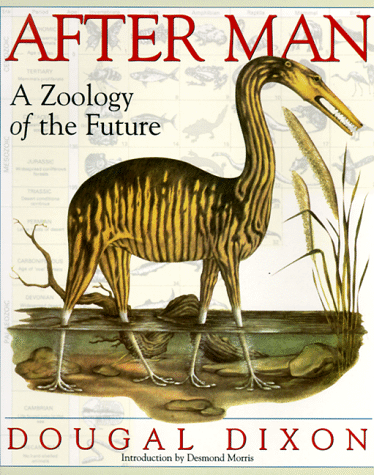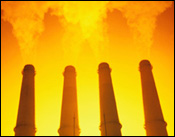Notes for Chapter 19:
Changing the Oceans by Changing the Atmosphere
Click link to return to Lecture
Schedule
or Lecture Notes by Chapter
Back to Chapter 18
This is Last Chapter (Back to Chapter
1)
Case History: Beyond Global
Warming
Featured
Organisms:
Snouters
(fictional mammals endemic to the
"Hi-I-Ay" Archipelago, invented
by zoologist, Dr. Harald Stümpke)
More Links: 1
- 2
- 3
- 4 - 5 - 6 - 7 - 8
Whale-sized snorkle-breathing animals
(fictional future
animals - invented
by
Dougal
Dixon in:  )
)
Available at Amazon.com
RQ 19.1: The fictional snorkle-breathing
whale-size
plankton feeder
living some 50 million years in
the future,
as invented by Dougal Dixon, is
descendent of
what type of animal living in today's
world?
I. The Effect of Global Warming on the World Oceans
terms: greenhouse gases,
greenhouse effect
More Links: 1 -
2 - 3
- 4 -
5 - 6
- 7 - 8
- 9
- 10

Send President
Bush a message about Global Warming
a) The Magnitude of Global
Warming
RQ 19.2: If CO2
is a rare gas in the atmosphere (i.e., compared
with O2,
for example, or compared with its concentration on
Venus),
then why is the documented
increase in its
concentration
reason for concern? How much has its
concentration
increased since pre-industrial
(before 1850)
levels?
b) Effects of Global Warming on Marine
Communities
RQ 19.3: Why are tropical marine
communities thought to
be especially
vulnerable to damage by warming waters?
c) Rising Sea Level
d) The Worrisome Possibility of Positive
Feedback
terms: positive feedback
RQ 19.4: Briefly describe how positive
feedback might operate
in the ocean's
response to global warming and why this
possibility
is considered worrisome. Bring the example of
North Pacific
vs. Tropical Pacific annual exchange of CO2
into the comparison
(see Fig. 19.5).
e) An Iron Fix for the Southern Ocean?
RQ 19.5: One idea to slow global
warming is to "seed" the
Southern Ocean
with a form of iron that could be used
by phytoplankton.
Why is this strategy probably doomed
to provide only
limited help, at best, even if it were
possible?
f) Stopping the Greenhouse Effect
II. The Depletion of Stratospheric Ozone
terms: ultraviolet-B (UV-B),
ultraviolet-A (UV-A)
a) Effects of Human Activities on Ozone
terms: stratosphere
b) Ultraviolet-B
at Ground Level
c) UV-B Effects on Marine Organisms
RQ 19.6: Briefly describe a specific
example of a scientific
demonstration
that UV-B can be detrimental
to the
growth or life
of marine organisms. Also describe
evidence that
some marine organisms are better able
to cope with
UV-B than others.
d) Possible Effects of Increased Ultraviolet
Radiation
on Marine Communities
terms: photoenzymatic repair
e) Confronting the Ozone Challenge
terms: Montreal Protocol
RQ 19.7: How thick is the Earth's
normal ozone layer
in the stratosphere, and why are human-made
chlorofluorocarbons (CFCs) more of a
threat to it than are natural sources of chlorine
(Cl), such as Cl discharged from volcanos?
What danger might a further expansion of a
seasonal
hole in the ozone layer near Antarctica
pose for marine organisms in the Southern Ocean?
How might this problem be relatively easy to
prevent, even if changes are not expected
to be immediate?
III. Effects of DMS on Clouds and Climate
terms: cloud condensation nuclei (CCN)
RQ 19.8: How might the ocean's natural
release of
dimethyl sulfide (DMS) moderate the impact
of global warming due to expanding CO2
levels?
The Author's Last Word: Saving
the Oceans-
and Humanity (pp. 457-458)
RQ 19.9: According to David Milne,
what is the
only solution for the long-term health
of the oceans and the rest of the planet?
Click link to return to Lecture
Schedule
or Lecture Notes by Chapter
Back to Chapter 18
This is Last Chapter (Back to Chapter
1)
This page created 5/11/01 © D.J. Eernisse, Last Modified 5/14/01
 )
)
